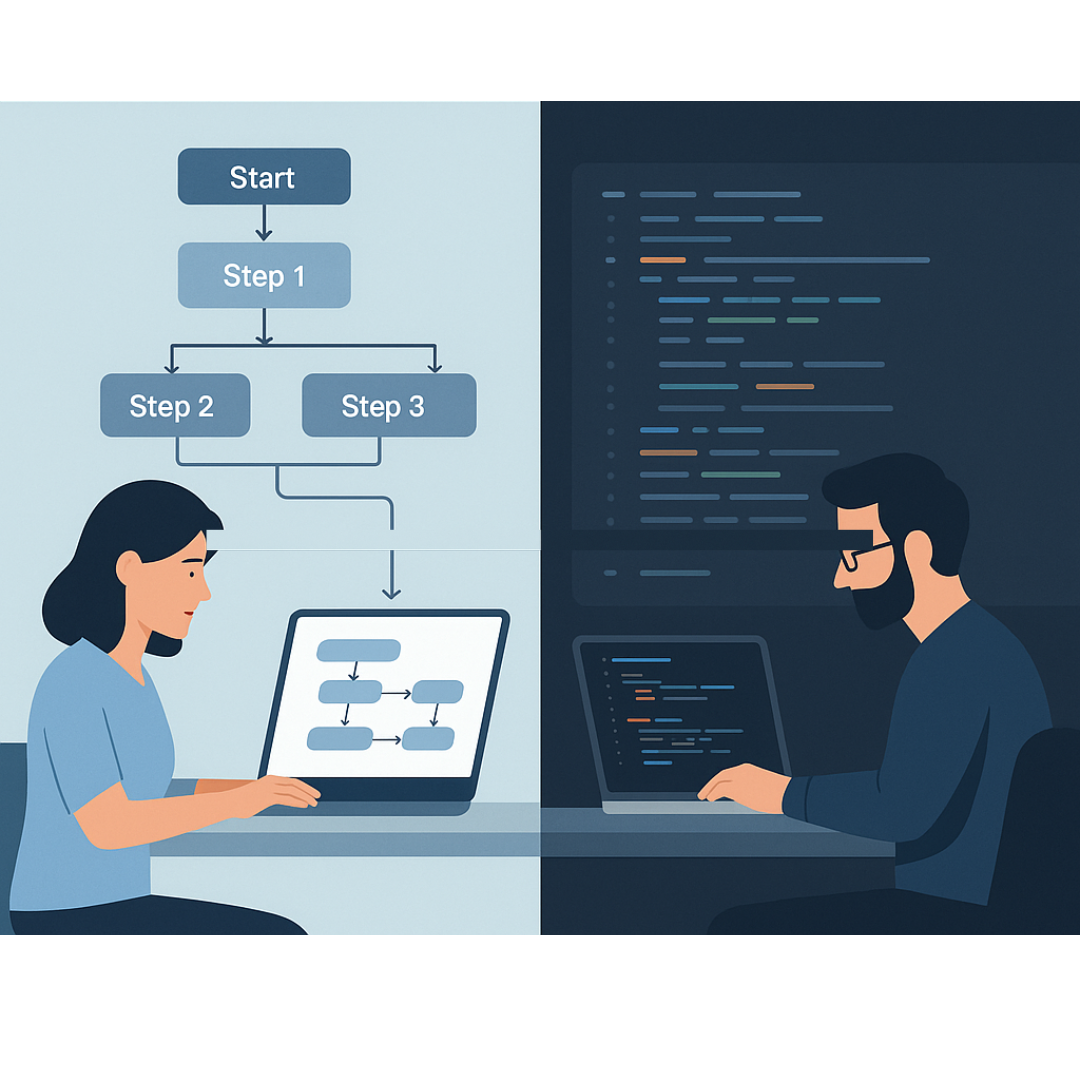Every business leader today faces the same critical question: How do we harness AI automation to drive growth without getting bogged down in technical complexity? The answer isn’t just about choosing the right technology; it’s about understanding when to leverage third-party platforms versus investing in custom solutions.
After evaluating dozens of automation platforms, I’ve identified a clear framework that can help you make this decision with confidence. Let me share what I’ve learned about two approaches that represent opposite ends of the spectrum.
The Hidden Risks: Why AI Agent Orchestration Isn’t Just a Technology Decision
Before diving into platforms, let’s address the elephant in the room: AI agents aren’t just tools; they’re autonomous actors that can make decisions, access sensitive data, and represent your brand. This creates unprecedented security and compliance challenges that many businesses underestimate.
The Security Reality
When you deploy AI agents, you’re essentially giving software the ability to:
- Access customer data across multiple systems
- Make decisions that affect business outcomes
- Communicate on behalf of your company
- Process sensitive information without human oversight
The risk? A misconfigured agent could expose customer data, make unauthorized purchases, or send inappropriate communications. Unlike traditional automation, which follows rigid rules, AI agents adapt and learn, meaning their behavior can evolve in unexpected ways.
The Expertise Gap
Here’s what most businesses miss: your employees need to become AI orchestrators, not
just users. This requires understanding:
- How to design prompts that consistently produce desired outcomes
- When to implement human oversight vs. autonomous operation
- How to monitor and audit AI agent behavior
- What data should and shouldn’t be accessible to agents
This isn’t about learning new software—it’s about developing entirely new skills around AI governance and risk management.
The Automation Spectrum: From Simple to Sophisticated
Business automation isn’t one-size-fits-all. Your needs likely fall somewhere on this spectrum:
Level 1: Quick Wins – Simple, repetitive tasks that eat up your team’s time
Level 2: Process Optimization – Multi-step workflows that require human oversight
Level 3: Intelligent Operations – Complex, adaptive systems that learn and evolve
- A complete re-architecture for performance, flexibility, and long-term scale
- Designed to integrate with modern tools while preserving institutional knowledge
- Built around data stewardship, security, and user trust
Understanding where your needs fall determines whether you should buy a platform or build a
custom solution—and how much investment you need in security and training.
The Platform Approach: Relay.app
Best for: Business leaders who need results fast and want their teams to own the process. Think of Relay.app as the “business-first” approach to automation. It’s designed around a simple premise: your subject matter experts should be able to build and modify workflows without waiting for IT.
Why This Matters for Your Business
Speed to Market: Your marketing team can build lead qualification workflows in hours, not weeks. Your sales team can automate follow-up sequences without submitting IT tickets.
Human Oversight Built-In: Unlike rigid automation that breaks when exceptions occur, Relay.app expects human judgment. Need approval for expenses over $500? Want manual review of AI-generated content? It’s built into the workflow, not bolted on afterward.
Real Business Impact:
- A marketing agency used Relay.app to automate client onboarding, reducing setup time from 3 days to 30 minutes
- A sales team automated their lead scoring and routing, increasing qualified leads by 40%
- An operations team built approval workflows that eliminated email bottlenecks
The Security Trade-offs
Data Control: Cloud-based platforms mean your data flows through third-party servers. While Relay.app has security certifications, you’re still trusting another company with your business-critical information.
The Training Data Question: Here’s what most businesses overlook: many third-party platforms use your data to enhance their models. Every customer interaction, every business process, and every proprietary workflow you run through their system can potentially become training data for their AI models. Are you comfortable building someone else’s competitive advantage with your proprietary data?
Access Management: Simple doesn’t mean secure. Easy-to-use platforms can make it too easy for agents to access sensitive data. The question isn’t whether your team can build an agent—it’s whether they should do so without proper security protocols.
Compliance Blind Spots: Regulations like GDPR, CCPA, and industry-specific compliance requirements weren’t written with AI agents in mind. You need to ensure your agents don’t inadvertently violate data protection laws
The Technical Approach: n8n.io
Best for: Businesses with technical resources who need maximum flexibility n8n.io represents the “engineering first” approach. It’s powerful, customizable, and can integrate with virtually anything—but it requires technical expertise to unlock its potential.
Why This Might Be Right for Your Business
No Limits: If you can imagine it, n8n.io can probably do it. Complex data transformations, multi-system integrations, sophisticated error handling—it’s all possible.
Cost Control: Being open-source means you can self-host and avoid per-user fees as you scale.
For large organizations, this can mean significant cost savings.
Integration Powerhouse: With 400+ pre-built connectors and the ability to connect to any REST API, you can automate across your entire tech stack.
The Security Advantages
Full Control: Self-hosting ensures that your data remains within your infrastructure. For regulated industries or sensitive business data, this level of control is often non-negotiable.
Data Sovereignty: Your proprietary data stays proprietary. You’re not inadvertently training competitors’ models with your unique business processes, customer insights, or operational knowledge.
Audit Trail: Technical platforms typically offer detailed logging and monitoring capabilities, making it easier to track what your agents are doing and ensure compliance.
Granular Permissions: Enterprise-grade access controls let you implement the principle of least
privilege, agents only get access to what they absolutely need.
The Expertise Requirements
The flip side? Your team needs deep technical expertise to implement security correctly. Misconfigured permissions, inadequate monitoring, or poor data handling can create bigger risks than a managed platform.
The Decision Framework: Buy
vs Build
Here’s how to decide which approach fits your business:
Here’s how to decide which approach fits your business:
Your Priority is Speed and Adoption
- You need automation running within weeks, not months
- You want business users to own and modify workflows
- You’re starting your automation journey
- You’re comfortable with data sharing trade-offs for convenience
Human Oversight is Critical
- Approval processes are part of your workflows
- You need flexibility for exceptions and edge cases
- Compliance requires human review steps
Technical Resources are Limited
- You don’t have dedicated developers for automation
- Your IT team is focused on core systems
- You want to avoid custom code maintenance
Important caveat: Carefully review data usage policies. Some platforms reserve the right to use your data for model training, which could mean your proprietary business processes are helping improve competitors’ capabilities.
Choose Custom Development (n8n.io) When:
You Have Complex Requirements
- Your workflows span multiple systems with different data formats
- You need sophisticated error handling and retry logic
- Custom business logic is essential
You Have Technical Resources
- You have developers who can build and maintain workflows
- Your IT team wants full control over the automation stack
- You’re comfortable with code-based configuration
Data Protection is Non-Negotiable
- Your proprietary data provides competitive advantage
- You’re in a regulated industry with strict data requirements
- You don’t want to risk training competitors’ models with your data
Scale and Control Matter
- You’re automating across hundreds of users
- Self-hosting is important for security/compliance
- You need to integrate with legacy or proprietary systems
The Hybrid Approach: Why Not Both?
The most successful businesses I’ve worked with don’t choose one approach—they use both strategically:
- Start with platforms for quick wins and business-user adoption
- Graduate to custom solutions for complex, high-value processes
- Use platforms for prototyping new automation ideas before building custom
Common Pitfalls to Avoid
Don’t Skip the Foundation AI agent deployment without proper assessment and training is like giving someone a sports car without teaching them to drive. You need to understand your organization’s AI readiness before deploying agents.
Don’t Ignore Governance Every AI agent needs clear boundaries, monitoring, and
accountability measures. Who’s responsible when an agent makes a mistake? How do you ensure consistent behavior across different use cases?
Don’t Underestimate Training Needs Your team needs to become AI orchestrators. This means understanding prompt engineering, recognizing AI limitations, and knowing when human intervention is required.
The Right Way to Get Started
The choice between platforms and custom development isn’t about finding the “best” tool—it’s about building AI capabilities responsibly while driving business value. The reality is that organizations need to be experimenting with AI agents now to stay competitive, but they need to do it strategically.
The Competitive Imperative
While security and compliance are critical, the bigger risk might be standing still. Your
competitors are already experimenting with AI agents to:
- Accelerate sales cycles and improve conversion rates
- Reduce support costs while improving customer satisfaction
- Streamline operations and eliminate manual bottlenecks
The question isn’t whether to start—it’s how to start in a way that manages risk while building real capability.
Start with Assessment, Not Technology
Before choosing any platform, you need to understand where your organization stands. An AI Readiness Assessment helps you identify:
- Current security posture and compliance requirements
- Team skill gaps and training needs
- High-impact use cases that justify investment
- Risk tolerance and governance requirements
This assessment doesn’t slow you down—it ensures your first experiments deliver results while building the foundation for larger deployments.
Prove Value with Focused Pilots
Once you understand your readiness, start with specific, measurable use cases that deliver near-term ROI:
Sales Automation: Deploy AI agents to qualify leads, schedule meetings, and follow
up with prospects. This contained environment lets you test agent behavior while driving clear revenue impact. Many organizations see 20-30% improvements in lead response times and conversion rates.
Customer Support: Use AI agents to handle routine inquiries, escalate complex issues, and maintain consistent service quality. Support interactions provide rich data for measuring agent effectiveness while reducing costs and improving customer satisfaction.
These focused applications let you build expertise and confidence while demonstrating tangible business value to stakeholders.
Build Your AI Orchestration Capabilities
Success with AI agents requires more than just deploying technology. Your team needs:
- Prompt engineering skills to guide agent behavior
- Risk assessment capabilities to identify potential issues
- Monitoring and optimization expertise to maintain performance
- Governance frameworks to ensure responsible use
The key is building these capabilities through practical application, not theoretical training. Real pilots with real business impact create the expertise you need for larger deployments.
The Digital Scientists’ Advantage
This is where working with experienced partners becomes valuable. Digital Scientists can help you navigate this journey with a practical, manageable approach that focuses on near-term ROI while building internal capability
Rather than getting overwhelmed by the technology landscape or paralyzed by risk concerns, you can start with proven frameworks, established best practices, and guidance from teams who’ve already solved these challenges.
The right approach balances speed with safety—moving fast enough to capture competitive advantage while building the governance and expertise needed for long-term success.
Ready to start your AI agent journey?
Schedule a consultation to discuss your specific needs, or learn more about our AI Readiness Assessment to understand where your organization stands. What specific business outcomes are you looking to achieve with AI agents?


